Baby Powder & Cutting Wood Type

People who know me have often heard me say that “Cutting wood is a constant learning curve”. I have spent the past two years doing research on-line, in reference books I have purchased from Amazon or read at the Ohio Historical Center in Columbus. I have duplicated type specimen books, spent hours on the Flicker photo sites of experts like Nick Sherman and other visitors to the Hamilton Wood Type Museuem at Two Rivers, Wisconsin. Once you know what to look for in a picture of a 120 year old machine you can figure out a lot of answers.
I have made three trips to Two Rivers with my letterpress printer daughter to research cutting type, type trimming, pattern making, maple preparation, border stamping machines, printing presses, and historical tools. I have been lucky enough to talk about wood type with all the leading experts from around the world.
 I have had a two hour private lesson from Norb Brylski on the entire process from design patterns to trimming. Once I had completed my replica of the Hamilton Pantograph type cutter on a second trip, Norb spent another few hours answering questions and teaching me how to set-up and calibrate my big pantograph. He solved a set-up problem that had haunted me for 2 months of trying to correct a .020 inch cutting problem with a 20 second answer. That kind of knowledge only comes from years of type cutting experience.
I have had a two hour private lesson from Norb Brylski on the entire process from design patterns to trimming. Once I had completed my replica of the Hamilton Pantograph type cutter on a second trip, Norb spent another few hours answering questions and teaching me how to set-up and calibrate my big pantograph. He solved a set-up problem that had haunted me for 2 months of trying to correct a .020 inch cutting problem with a 20 second answer. That kind of knowledge only comes from years of type cutting experience.
I make my patterns out of 1/4 inch Baltic birch plywood nailed to a 1/2 inch baltic birch background block like they do at Hamilton. I have choosen not to make them two sided like some type companies did. I glue and hand nailed each pattern piece. However, I use modern industrial glues and a digital caliper to be sure the spacing is square, and that the pattern a perfect copy of the original.
One of the best things I have figured out on my own is to “Lubricate” the pattern with baby powder. The talc (or cornstarch) in the baby powder allows the steel tracer to slide on the edge of the wooden pattern. The bottom end of the steel tracer never actually touches the bottom of the pattern, It glides on the pantograph pivot points 1/16” above the wood.  The baby powder packs into the sides of the pattern and allows the operator to gently slide the tracer around the pattern with very little wear. However, on my big Hamilton pantograph, the baby powder tends to spread out on the sheet aluminum top.
The baby powder packs into the sides of the pattern and allows the operator to gently slide the tracer around the pattern with very little wear. However, on my big Hamilton pantograph, the baby powder tends to spread out on the sheet aluminum top.
Besides making the patterns last longer, the smell of the baby powder reminds me of a favorite memory…. the wonderful smell of my daughter Erin when she was a baby and I used to sing and rock her to sleep 28 years ago.



